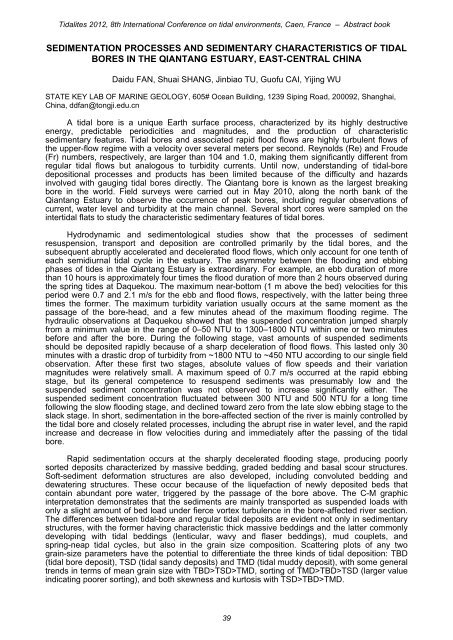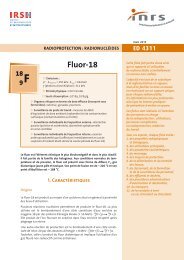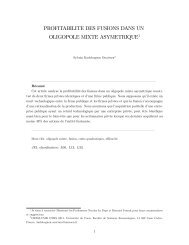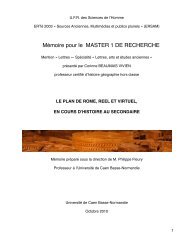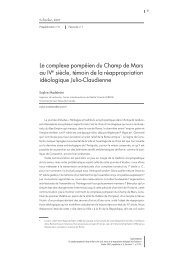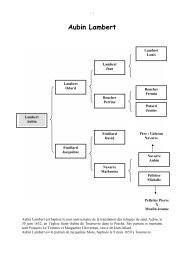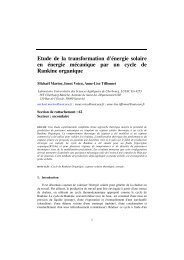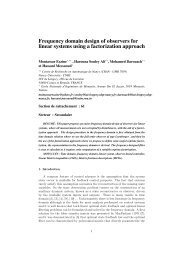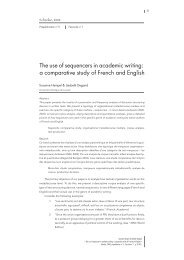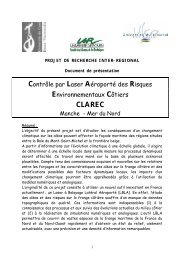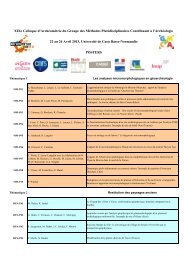programme tuesday, july, 31 - Université de Caen Basse Normandie
programme tuesday, july, 31 - Université de Caen Basse Normandie
programme tuesday, july, 31 - Université de Caen Basse Normandie
Create successful ePaper yourself
Turn your PDF publications into a flip-book with our unique Google optimized e-Paper software.
Tidalites 2012, 8th International Conference on tidal environments, <strong>Caen</strong>, France – Abstract book<br />
SEDIMENTATION PROCESSES AND SEDIMENTARY CHARACTERISTICS OF TIDAL<br />
BORES IN THE QIANTANG ESTUARY, EAST-CENTRAL CHINA<br />
Daidu FAN, Shuai SHANG, Jinbiao TU, Guofu CAI, Yijing WU<br />
STATE KEY LAB OF MARINE GEOLOGY, 605# Ocean Building, 1239 Siping Road, 200092, Shanghai,<br />
China, ddfan@tongji.edu.cn<br />
A tidal bore is a unique Earth surface process, characterized by its highly <strong>de</strong>structive<br />
energy, predictable periodicities and magnitu<strong>de</strong>s, and the production of characteristic<br />
sedimentary features. Tidal bores and associated rapid flood flows are highly turbulent flows of<br />
the upper-flow regime with a velocity over several meters per second. Reynolds (Re) and Frou<strong>de</strong><br />
(Fr) numbers, respectively, are larger than 104 and 1.0, making them significantly different from<br />
regular tidal flows but analogous to turbidity currents. Until now, un<strong>de</strong>rstanding of tidal-bore<br />
<strong>de</strong>positional processes and products has been limited because of the difficulty and hazards<br />
involved with gauging tidal bores directly. The Qiantang bore is known as the largest breaking<br />
bore in the world. Field surveys were carried out in May 2010, along the north bank of the<br />
Qiantang Estuary to observe the occurrence of peak bores, including regular observations of<br />
current, water level and turbidity at the main channel. Several short cores were sampled on the<br />
intertidal flats to study the characteristic sedimentary features of tidal bores.<br />
Hydrodynamic and sedimentological studies show that the processes of sediment<br />
resuspension, transport and <strong>de</strong>position are controlled primarily by the tidal bores, and the<br />
subsequent abruptly accelerated and <strong>de</strong>celerated flood flows, which only account for one tenth of<br />
each semidiurnal tidal cycle in the estuary. The asymmetry between the flooding and ebbing<br />
phases of ti<strong>de</strong>s in the Qiantang Estuary is extraordinary. For example, an ebb duration of more<br />
than 10 hours is approximately four times the flood duration of more than 2 hours observed during<br />
the spring ti<strong>de</strong>s at Daquekou. The maximum near-bottom (1 m above the bed) velocities for this<br />
period were 0.7 and 2.1 m/s for the ebb and flood flows, respectively, with the latter being three<br />
times the former. The maximum turbidity variation usually occurs at the same moment as the<br />
passage of the bore-head, and a few minutes ahead of the maximum flooding regime. The<br />
hydraulic observations at Daquekou showed that the suspen<strong>de</strong>d concentration jumped sharply<br />
from a minimum value in the range of 0–50 NTU to 1300–1800 NTU within one or two minutes<br />
before and after the bore. During the following stage, vast amounts of suspen<strong>de</strong>d sediments<br />
should be <strong>de</strong>posited rapidly because of a sharp <strong>de</strong>celeration of flood flows. This lasted only 30<br />
minutes with a drastic drop of turbidity from ~1800 NTU to ~450 NTU according to our single field<br />
observation. After these first two stages, absolute values of flow speeds and their variation<br />
magnitu<strong>de</strong>s were relatively small. A maximum speed of 0.7 m/s occurred at the rapid ebbing<br />
stage, but its general competence to resuspend sediments was presumably low and the<br />
suspen<strong>de</strong>d sediment concentration was not observed to increase significantly either. The<br />
suspen<strong>de</strong>d sediment concentration fluctuated between 300 NTU and 500 NTU for a long time<br />
following the slow flooding stage, and <strong>de</strong>clined toward zero from the late slow ebbing stage to the<br />
slack stage. In short, sedimentation in the bore-affected section of the river is mainly controlled by<br />
the tidal bore and closely related processes, including the abrupt rise in water level, and the rapid<br />
increase and <strong>de</strong>crease in flow velocities during and immediately after the passing of the tidal<br />
bore.<br />
Rapid sedimentation occurs at the sharply <strong>de</strong>celerated flooding stage, producing poorly<br />
sorted <strong>de</strong>posits characterized by massive bedding, gra<strong>de</strong>d bedding and basal scour structures.<br />
Soft-sediment <strong>de</strong>formation structures are also <strong>de</strong>veloped, including convoluted bedding and<br />
<strong>de</strong>watering structures. These occur because of the liquefaction of newly <strong>de</strong>posited beds that<br />
contain abundant pore water, triggered by the passage of the bore above. The C-M graphic<br />
interpretation <strong>de</strong>monstrates that the sediments are mainly transported as suspen<strong>de</strong>d loads with<br />
only a slight amount of bed load un<strong>de</strong>r fierce vortex turbulence in the bore-affected river section.<br />
The differences between tidal-bore and regular tidal <strong>de</strong>posits are evi<strong>de</strong>nt not only in sedimentary<br />
structures, with the former having characteristic thick massive beddings and the latter commonly<br />
<strong>de</strong>veloping with tidal beddings (lenticular, wavy and flaser beddings), mud couplets, and<br />
spring-neap tidal cycles, but also in the grain size composition. Scattering plots of any two<br />
grain-size parameters have the potential to differentiate the three kinds of tidal <strong>de</strong>position: TBD<br />
(tidal bore <strong>de</strong>posit), TSD (tidal sandy <strong>de</strong>posits) and TMD (tidal muddy <strong>de</strong>posit), with some general<br />
trends in terms of mean grain size with TBD>TSD>TMD, sorting of TMD>TBD>TSD (larger value<br />
indicating poorer sorting), and both skewness and kurtosis with TSD>TBD>TMD.<br />
39


